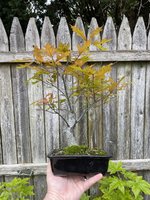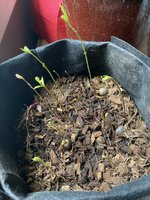Gabler
Masterpiece

I’ve been enjoying my little pin oak, and I’d love to see the species get some more attention. It seems as far as Quercus spp. are concerned, it’s the white oaks that get all the love. I’d like to determine whether that’s for good reason or just because pin oaks aren’t a traditional bonsai species.
The species has a number of advantages based on my admittedly anecdotal experience. Firstly, the leaves on wild trees are small compared to most other oak species—not as small as live oaks and willow oaks, but no bigger than most landscape Japanese maples. Secondly, they respond well to harsh root pruning. They certainly don’t respond as well as elms, but you don’t need to baby them. Thirdly, they backbud profusely when pruned, and they naturally grow with short internodes. I haven’t pinched my tree, but it’s been naturally inclined to develop a fairly twiggy structure. Lastly, the natural growth habit of the pin oak resembles a formal upright bonsai, a style many consider to look “unnatural.” Even young trees have good taper, downward-sweeping branches, and a strong basal flare. It’s no wonder they’re a popular landscaping tree for large spaces.

I haven’t managed to root any cuttings or air layers, but they’re easy to grow from seed. I collected a handful of acorns from a parking lot last fall, and 100% of the acorns germinated this spring. I just stuck them outside in a grow bag filled with coconut husk chips (folded closed to keep the squirrels from digging), and let the rain and snow water them from November to April. They’re currently inside by an open south-facing window to keep the squirrels from digging them all up before they’re well-rooted. They’ll go back outside soon.







